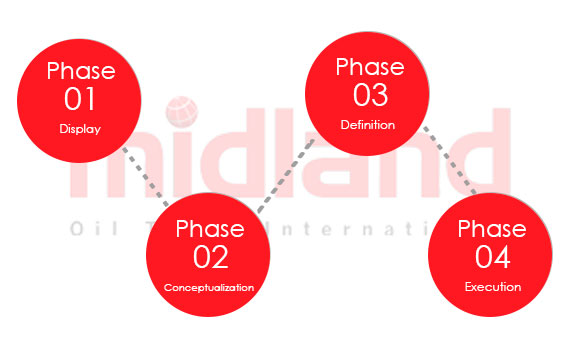
To ensure optimum performance of our services use a proprietary methodology called Productivity Solutions, based in Project Management, with a view to generate ground-surface solutions.
During diagnosis of the wells and engineering solutions we develop the following activities per phase:
In this phase we identify preliminarily optimization opportunities that might be in the group of selected wells. To minimize uncertainties regarding the diagnosis and the recommended path with preliminary estimates to generate profit after the work is done we follow these activities:
1. Evaluation and selection of available data and information about wells and reservoirs. Filling in forms depending on the type of information and load information systems in the suite of applications to be use: Oil Field Manager (OFM), AUTOCAD, EXCEL, WellFlo , PIPESIM, PROSPER, and so on.
The customer will provide a compilation of existing geoscience information on sites, records of wells, surface facilities that include location and history of drilling, completion and previous work, which will be used for assessment diagnosis and generation of recommendations for the client.
After gathering the information our specialists Geosciences, Reservoir Engineering, Well Completion and Productivity on wells. They analyze the Information as classified based on: Reservoir, wells, facilities and production Specific history.
Activities are performed as follows:
2. Overall assessment of the site by using a suite of applications to identify the distribution of the most important parameters of reservoir (lithology, porosity, permeability, net viscosity, natural fractures, etc.). And fluid (saturation density, solubility, compressibility, etc.) which can generate and analyze graphs of iso-complex properties and calculated variables.
3. Identification of a candidate well with a preliminary diagnosis that includes: conventional reservoir analysis, review of geological and petro-physical information available review the completion of the well and analysis of production history.
4. Integral nodal analysis including well to well from the drainage area to the head which will diagnose problems typical of formation damage, well connectivity - reservoir operation of artificial lift equipment and bottlenecks in the well completion.
The conceptualization stage is to identify the candidate well and explore the various job options to optimize the candidates. We choose the best alternative that is suited technically and economically to the requirement of the client. We perform the respective conceptual and basic engineering. At this stage the activities include:
The Definition phase is based on the results of the previous phases, we select the alternative that generates both value for its technical feasibility and lower uncertainty. This Optimization Program is generated as follows. The activities are:
- Summary of the static model, rock properties and fluid
- Verification of reserves by the volumetric method probabilistic
- Graphics iso-properties (f, K, Sw, So, Np, Qo, etc.).
- Historical information and statistics on production and pressure
- Areas of the deposits, productivity rates and remaining reserves
- Distribution of areas according to the "Reservoir Complexity Index"
- Preliminary selection of candidates for optimizing the wells
- Information of the wells tested (summary of drilling and previous interventions current completion and production history).
- Functional Requirements (OOIP, remaining reserves, well integrity, degree of difficulty for the optimization work, etc.).
- Criteria for selection as a candidate well to revive and assessment of potential optimization and rehabilitation work.
- Selection of candidate wells for optimization.
- Changes in the well completion and equipment
- Selection of equipment required for the well intervention
- Calculating the costs associated with the proposed work
- Calculate probability of remaining volume of oil to produce
- Forecast of production on the economic horizon
- Economic evaluation and risk analysis
At the site where the work will be executed Midland Oil Tools, together with representatives of the field operator ( owner ) will monitor:
The evaluation of the field or group of wells selected by the operator will be executed by Midland Oil Tools applying Project Management methodology to ensure compliance with the objective of creating a portfolio of wells suitable for recovery, quality and expected resources.
The selection will be done following an established process which is framed in the comprehensive methodology Productivity Solutions. The portfolio of selected wells will be subjected to a strict hierarchy based on estimated contributions of production and profitability this in terms of net present value internal rate of return and investment efficiency of each proposal.